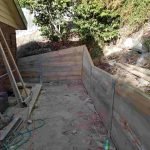Introduction
Retaining walls are more than simply practical structures; they are a vital part of landscaping and engineering that can improve the aesthetic appeal of any residential or commercial property. As urbanization continues to rise, so does the need for ingenious style and setup methods. With a plethora of choices readily available-- from timber sleepers to concrete sleepers, and even innovative products like H beams-- the landscape of retaining wall design is ever-evolving. This short article aims to explore The Latest Patterns in Retaining Wall Style and Installation, clarifying contemporary methods, products, and professional recommendations.
The Newest Trends in Retaining Wall Style and Installation
As we dive deeper, it's crucial to understand what constitutes the current trends in retaining wall style and installation. In recent years, there has been a noticeable shift towards sustainability, visual appeals, and functionality. Property owners are now more worried about how their keeping walls suit the overall landscape design while likewise prioritizing durability.
1. Sustainability in Materials
1.1 Environment-friendly Options
Sustainable products like recycled concrete or sustainably sourced wood are acquiring traction. These materials not just reduce environmental effect but also provide unique aesthetic qualities.
1.2 Permeable Designs
Permeable keeping walls allow water drain, avoiding soil disintegration while promoting natural groundwater recharge. This trend aligns with eco-conscious landscaping practices.
2. Ingenious Engineering Techniques
2.1 Modular Blocks
Modular blocks have ended up being significantly popular due to their ease of installation and versatility. These blocks can be designed to imitate natural stone or other products, supplying visual versatility without compromising strength.
2.2 Enhanced Structures
Incorporating strengthened steel bars or fit together within concrete walls includes stability, allowing for taller installations without compromising safety.
3. Aesthetic Trends in Keeping Walls
3.1 Natural Stone Facades
The usage of natural stone facades produces a classic appearance that mixes perfectly with the environment. This pattern attract house owners seeking elegance integrated with durability.
3.2 Vertical Gardens
Integrating plant into retaining walls through vertical gardens is another interesting trend that boosts visual appeal while improving air quality.
4. Smart Innovation Integration
4.1 Automated Irrigation Systems
Smart irrigation systems incorporated into keeping walls guarantee optimum wetness levels for any plants incorporated into the structure, thereby improving plant health.
4.2 Monitoring Systems
Advanced sensors can keep an eye https://rentry.co/owvgibt8 on soil pressure and wetness levels, informing house owners when maintenance is required.
5. Diverse Product Use: Lumber vs Concrete vs H Beam
5.1 Timber Sleepers: Pros and Cons
Timber sleepers use an organic aesthetic but need routine maintenance due to vulnerability to rot and insect damage.
Pros:
- Aesthetically pleasing Easy to install
Cons:
- Requires maintenance Less resilient than concrete
5.2 Concrete Sleepers: Resilience Fulfills Versatility
Concrete sleepers have become a go-to option due to their long lifespan and low upkeep requirements.
Pros:
- Highly durable Fire-resistant
Cons:
- Heavier than timber Limited visual variation
5.3 H Beams: The Structural Marvels
H beams provide exceptional strength for large-scale tasks where conventional techniques might not be enough, making them an ideal option for business applications.
Professional Setup: Why It Matters?
When it comes to installing keeping walls, hiring experts can make all the difference in between success and disaster.
6. Competence Matters in Retaining Wall Projects
Professionals bring experience that makes sure security requirements are satisfied while attaining the desired look and performance of your wall.
7. Cost Efficiency Through Professionalism
While do it yourself might appear cost-effective at first, professional setup often results in less errors-- saving money in repair work down the line.
FAQs About Retaining Wall Design
Q1: What is the very best material for a keeping wall?
A1: The best product depends upon your particular requirements-- timber is terrific for visual appeals; concrete deals sturdiness; H beams provide structural stability for larger projects.
Q2: How high can a property retaining wall be?
A2: Generally, residential keeping walls should not go beyond 4 feet without professional engineering guidance due to safety concerns related to soil pressure.
Q3: Do I need a permit for constructing a maintaining wall?
A3: Yes, many municipalities require authorizations for keeping walls above a certain height-- check regional regulations before proceeding with construction.
Q4: How do I preserve my timber sleeper wall?
A4: Regular evaluations for indications of rot or insect damage are important; using sealants can extend its life expectancy significantly.
Q5: Can I build my own retaining wall?
A5: While do it yourself is possible for smaller walls using lighter products like wood sleepers, it's advised to speak with specialists for bigger installations or complicated designs.
Q6: Are there options to traditional maintaining walls?
A6: Yes! Alternatives include terracing or using natural stones which can be both functional and aesthetically pleasing while lowering disintegration danger effectively.

Conclusion
In conclusion, comprehending The Most current Patterns in Retaining Wall Design and Installation allows homeowners and contractors alike to make informed choices customized to their unique requirements-- balancing looks with functionality while thinking about sustainability concepts in addition to innovative innovation combination into landscape architecture today! Whether you opt for lumber sleepers, concrete sleepers, or advanced H beams-- the options are abundant! So take your time investigating each choice completely before diving into your next job!
Incorporating these modern-day trends not only elevates your residential or commercial property's curb appeal but also improves its worth significantly!